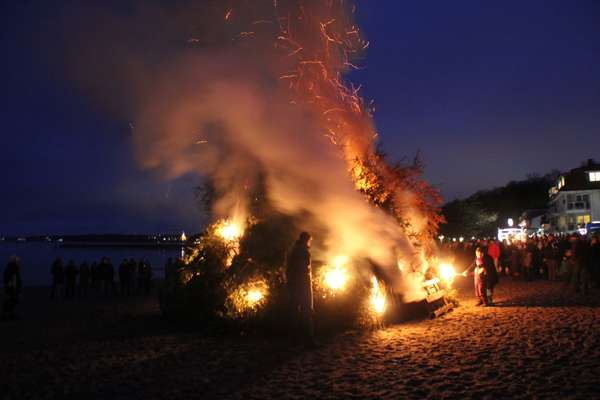Biikebrennen in North Frisia
- 21. February 2017 - General, Germany, Old Customs, Traditions
North Frisia is a part of the German state Schleswig-Holstein, it is located in the Northwest on the Northern Sea, it also includes the islands Sylt, Amrum, Föhr and smaller ones.
Maybe some of you have ancestors from North Frisia. The North Frisian emigration overseas began in the early 17th century. During that time sea men from the region travelled on Dutch vessels to New Amsterdam, what we know today as New York City. During the 19th century mass migration began from Europe – and from North Frisia. Today there is hardly a native family in the region that has no relatives or ancestors somewhere overseas.
Every year on 21 February the communities on the North Frisian islands, on the coast and in Southern Denmark say goodbye to winter by lighting bonfires shortly after sunset. Every community and even some farms have their own bonfires. Today the contents of the fires are old Christmas trees and decorations.
The word “biike” means fire signal. The origin of the Biikebrennen remains uncertain, but because of its name one assumption is that it might have been a fire signal for seafaring men. The biike fire has been around for a long time. It has its roots in the pre-Christian, Germanic era. Back then the people wanted to drive away the winter ghosts and the rough winter with the fire and they wanted to welcome the spring time. Even today sometimes a straw doll is burnt, originally it might have been as a symbol for winter. But tradition varies from village to village and island to island.
The 22 February is “Cathedra Petri” day, a Christian commemoration day. It is interesting that the above-mentioned straw doll was sometimes also called “Piader”, „little Peter“. Not the Saint Peter was symbolically burnt here but the pope as a symbol that in Germanic times the Christian faith was initially rejected in the region.
In the early modern times on the North Frisian coast and islands the Biikebrennen took place around the time when families said goodbye to their fathers and husbands when they left to go whaling. Not a small number of men earned a living for their families this way. Around 1700 about 3600 men from North Frisia, mainly from the islands Sylt and Föhr, went whaling. With the celebrations of Biikebrennen the population said farewell to winter, welcomed spring and at the same time said goodbye to the whalers – the bonfires were used for navigation and as a signal of farewell because the seafarers would be able to see the bonfires for some time as they travelled away. Whalers would be away for quite some time, they would return in late autmn. That is, if they returned at all. Some whalers died on the trip, today there are very interesting gravestones from whalers in the early modern times that can still be visited in cemeteries on Sylt, Amrum or Föhr. However, in studies on the subject it is controversial if the Biike bonfires were really light for the purpose of saying farewell to the whalers.
During the 19th century the tradition was buried in oblivion but came back to live after the Second World War when people started to appreciate their local heritage again. In December 2014 the Biikebrennen was put on the list of German immaterial cultural heritage.
Today Biikebrennen is still celebrated in North Frisia and other parts of Schleswig-Holstein, too.


19. October 2020
Great, and made use of it in my blogpost on Biikebrennen on www.frisiacoasttrail.blog